Related Research Articles
Isoetes histrix, the land quillwort, is an aquatic pteridophyte native to the Mediterranean region, northwestern Africa, and the coasts of western Europe northwest to Cornwall. It occurs mainly in temporarily wet habitats, otherwise called vernal pools.

Pseudacanthicus is a genus of medium to large-sized suckermouth armored catfishes native to South America, where found in the Amazon and Orinoco basins, as well as rivers of the Guianas. They are primarily found in fast-flowing waters, sometimes relatively deep. They are sometimes kept in aquariums.
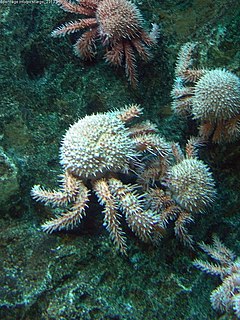
Paralomis histrix is a species of king crab which lives at a depth of 180–400 m (590–1,310 ft) in Tokyo Bay, Enshunada and through to Kyūshū. It has few predators because of its size and spiky carapace. It is sometimes kept in public aquariums and is occasionally referred to as the porcupine crab, a name otherwise used for Neolithodes grimaldii.

The spiny seahorse, also referred to as the thorny seahorse, is a small marine fish in the family Syngnathidae, native to the Indo-Pacific area. It is classified as a Vulnerable species by the IUCN.
Pseudacanthicus histrix is a large species of armored catfish endemic to Brazil where it occurs in the Rio Negro and lower Amazon basins. This species grows to a total length of 90 cm (3 ft). P. histrix has incredibly elongated odontodes that form a brush on the anterior margin of the pectoral fin spine in breeding males; however, sexual dimorphism has not been reported for the other Pseudacanthicus species.
Raphitoma histrix is an extinct species of sea snail, a marine gastropod mollusk in the family Raphitomidae.
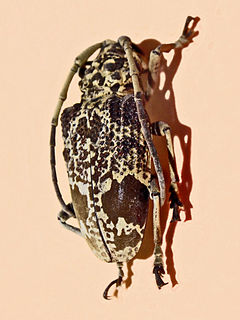
Phryneta is a genus of flat-faced longhorn beetles belonging to the family Cerambycidae.

Phrynetini is a tribe of longhorn beetles of the subfamily Lamiinae. It was described by Thomson in 1864.
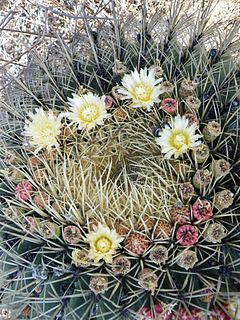
Ferocactus histrix is a species of Ferocactus from Mexico.

The Castilloa Borer is a species of beetle in the family Cerambycidae. It was described by Johan Christian Fabricius in 1775, originally under the genus Lamia. It has a wide distribution throughout Africa. It feeds on Morus alba, Hevea brasiliensis, Coffea arabica, and Chlorophora excelsa.

Phryneta aurocincta is a species of beetle in the family Cerambycidae. It was described by Félix Édouard Guérin-Méneville in 1832, originally under the genus Lamia. It has a wide distribution throughout Africa.
Phryneta coeca is a species of beetle in the family Cerambycidae. It was described by Chevrolat in 1857. It is known from Tanzania, the Central African Republic, the Ivory Coast, Cameroon, the Democratic Republic of the Congo, and Togo.
Phryneta conradti is a species of beetle in the family Cerambycidae. It was described by Hermann Julius Kolbe in 1894. It is known from the Democratic Republic of the Congo, Tanzania and Malawi.
Phryneta ellioti is a species of beetle in the family Cerambycidae. It was described by Charles Joseph Gahan in 1909. It is known from Uganda and the Democratic Republic of the Congo.
Phryneta ephippiata is a species of beetle in the family Cerambycidae. It was described by Francis Polkinghorne Pascoe in 1864. It is known from South Africa and Namibia.
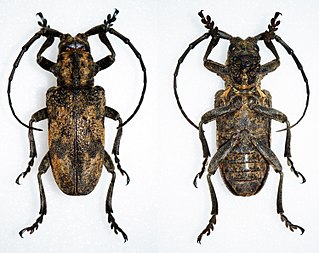
Phryneta obesa is a species of beetle in the family Cerambycidae. It was described by Westwood in 1845. It has a wide distribution in Africa.
Phryneta pallida is a species of beetle in the family Cerambycidae. It was described by James Thomson in 1857. It is known from South Africa.
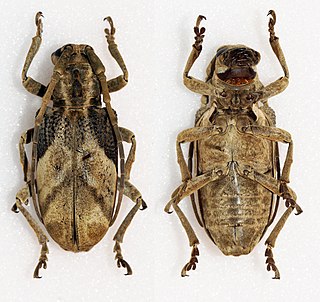
Phryneta semirasa is a species of beetle in the family Cerambycidae. It was described by Dohrn in 1885. It is known from Tanzania, the Democratic Republic of the Congo, Mozambique, Zimbabwe, Malawi, and Zambia.
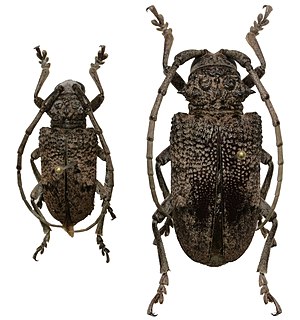
The Fig-tree Borer Longhorn Beetle, or Fig Tree Borer, is a species of beetle in the family Cerambycidae. It was described by Johan Christian Fabricius in 1792, originally under the genus Lamia. It has a wide distribution throughout Africa. It feeds on Pyrus communis, Ficus carica, Salix babylonica, Cupressus sempervirens, and Vitis vinifera.

Phryneta verrucosa is a species of beetle in the family Cerambycidae. It was described by Dru Drury in 1773, originally under the genus Cerambyx. It is known from Equatorial Guinea, and was introduced into Barbados, Grenada, and Trinidad and Tobago.
References
- ↑ BioLib.cz - Phryneta histrix. Retrieved on 8 September 2014.